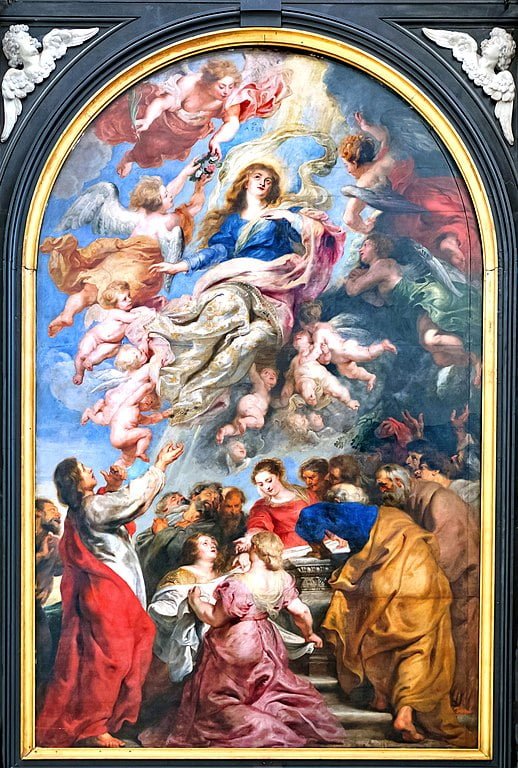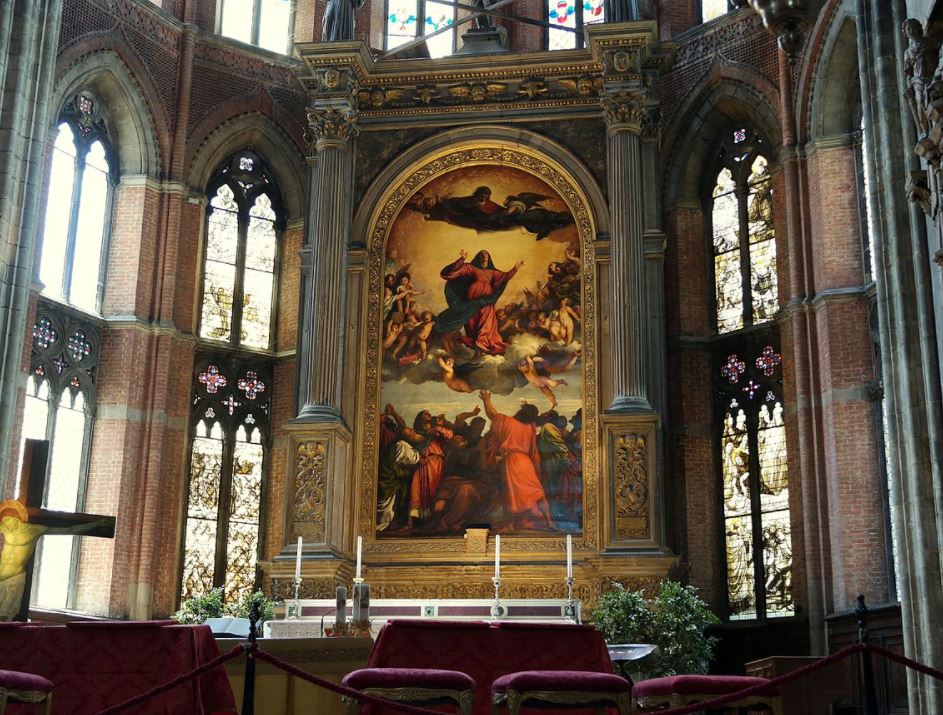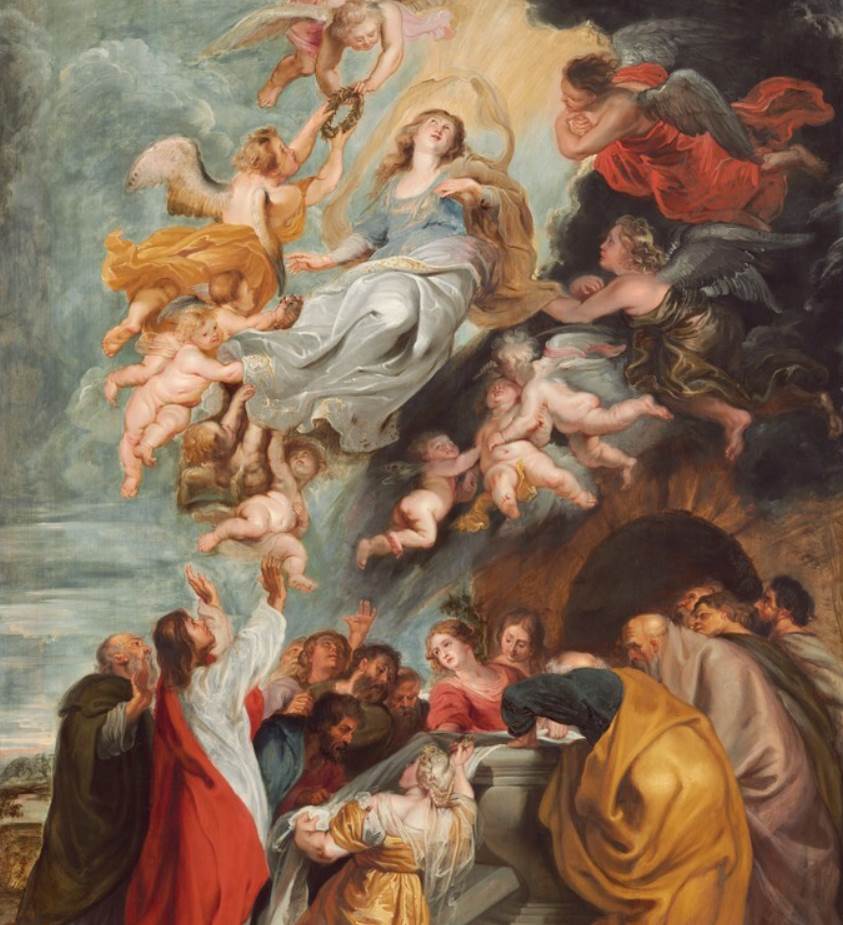Flemish artist Peter Paul Rubens (1577-1640), one of the greatest masters of the Baroque period, traveled all across Europe for extended periods. He did, however, have a home city where he established a huge workshop.
The city of Antwerp is one of the biggest port cities in the world and is located in modern-day Belgium. Rubens created most of his famous masterpieces here, including a work titled “The Assumption of the Virgin Mary.”
In this article, we’ll take a closer look at this magnificent work of art that never left the city where Rubens lived and worked for most of his life.
1. It was commissioned to decorate the high altar of an amazing church
When Peter Paul Rubens started working on this amazing painting in the first quarter of the 17th century, the Cathedral of Our Lady in Antwerp had already been consecrated for about a century. This happened in 1521 after construction had already started in 1352.
The Gothic cathedral was never completed because it was intended to feature 2 spires instead of the one we see today. Regardless, it’s the highest church tower in the Benelux at 123 meters (404 ft) high and the highest structure in the city as well.
The Assumption of the Virgin Mary was commissioned to decorate the high altar inside this remarkable building in Antwerp.

2. Rubens only completed the work 15 years after it was commissioned
The artist moved into a house that is now referred to as the “Rubenshuis” (Rubens House) in the year 1610. This was shortly after he returned from an extended period in Italy.
Just a year later, he earned the commission for this painting along with two other masterpieces known as “The Elevation of the Cross” (1610) and “The Descent from the Cross” (1611-1614).
Even though The Assumption of the Virgin Mary was commissioned together with these two other monumental works of art, he somehow didn’t manage to start working on it until 1625 and complete it in 1626. Yes, Rubens was a very busy man during this period in his life.
3. It depicts Mary being lifted up into the heavens above
As the name of the painting implies, it depicts Mary, the mother of Jesus Christ, being lifted into Heaven following the end of her life on Earth. This subject is pretty common in Christian art and has been painted by multiple great artists of the Renaissance and beyond.
Perhaps one of the most notable examples of this theme is the Assumption of Mary by Titian, a work also known as the “Frari Assumption” due to its location inside the Frari church in Venice.
Rubens surely admired this work of art during his visit to Italy as the composition of the work looks remarkably similar.

4. The painting represents the typical dramatic style of Baroque art
Even though Rubens refrained from including the typical naked voluptuous women in this painting, it can still be defined as a prime example of Baroque art of which Rubens was one of the greatest exponents.
The angels are spiraling beside Mary who is pulled towards the divine light above. Below are the 12 Apostles and women who are presumed to be Mary Magdalene and Mary’s two sisters.
The entire composition is the epitome of Baroque paintings which feature an intense sense of drama and emotion in the main figures.
5. It still hangs in the same location as it was commissioned for
The Elevation of the Cross is considered to be one of the prime examples of Rubens’ talent but still, it clearly shows the influence of the works he saw in Italy such as those of Titian and Michelangelo.
This is less the case with the Assumption of the Virgin Mary, a work that defines his style. After all, there are 15 years between the two works as well.
Today, you can still admire both of the masterpieces of this prolific Baroque artist in the Cathedral of Our Lady in Antwerp. Remarkably, the painting discussed in this article still decorates the high altar of the cathedral as well.

More interesting facts about the Assumption of the Virgin Mary by Rubens
6. Rubens didn’t mess about when he received commissions. Like most altarpieces, this oil on panel work of art was painted at a monumental scale with dimensions of 490 × 325 centimeters (190 × 128 inches).
7. Even though Rubens only completed the work in September of the year 1626, 15 years after he received the commission, it doesn’t mean that he didn’t start working on it earlier.
He already created models and preparatory drawings for this work for the management of the cathedral in February 1611. This makes it all the more remarkable that he wasn’t able to complete it much earlier.
8. Just like many other paintings by Peter Paul Rubens, he and his workshop created multiple versions of this painting. A smaller version was completed by his studio and is on display at the National Gallery of Art in Washington D.C.
Another version decorates St. Peter and Paul Church in Kirchheim in Schwaben, a small town in the southwest of Bavaria in Germany.

9. It’s assumed that the version in the National Gallery of Art in Washington D.C. is a replica of the original sketch that Rubens submitted to the clergy of the Cathedral in Antwerp.
This sketch can now be found at the Mauritshuis in The Hague, one of the most popular museums in the Netherlands. This museum features one of the most famous paintings in the world called “Girl with a Pearl Earring” by Johannes Vermeer.
10. This also means that the version in the United States is merely an enlarged copy of the original sketch and not by the hand of Rubens himself. It’s also much smaller than the version in Antwerp with dimensions of 123.5 x 92 centimeters (48.62 x 36.25 inches).
The main reason, however, why we can be assured that it’s merely an enlarged copy of the sketch made by Rubens is that the top left corner is empty. This indicates that the copier didn’t have a model since the sketch at the Mauritshuis has an arched shape in this location.



